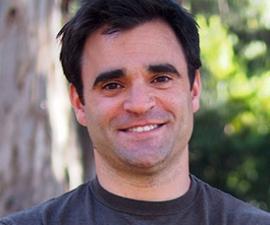NIH Systems NEUROSCIENCE SEMINAR SERIES
When: October 5, 2023, from 10:00 – 11:00 am
Presentation: Visual cortical circuits for segmentation, inference, and experience
Guest Speaker: Hillel Adesnik, Ph.D.
Seminar: Bldg. 35, Room 640

About the Speaker:
Hillel Adesnik Ph.D.
Associate Professor
Dept. of Molecular and Cellular Biology
University of California, Berkeley
Research
Our brain is responsible for all our perceptions, thoughts and actions. Despite the incredible array of processes the brain performs - from memory to emotion - its elementary units of function are the nerve cell and the synaptic junction. How is it that a collection of neurons and their synapses gives rise to all of animal and human behavior?
In mammals and especially in humans, the cerebral cortex is an area of the brain that is crucially involved in nearly all cognitive functions. Individual neurons in the cortex can make over 10,000 connections with other brain cells. The precise pattern of connections between a local group of neurons in the cortex gives rises to its elementary unit of computation - the cortical microcircuit.
The goal of our laboratory is to reveal the neural basis of perception. More specifically, we want to understand exactly how cortical microcircuits process sensory information to drive behavior. While decades of research have carefully outlined how individual neurons extract specific features from the sensory environment, the cellular and synaptic mechanisms that permit ensembles of cortical neurons to actually process sensory information and generate perceptions are largely unknown.
Addressing this fundamental question of modern neuroscience requires working at both the cellular and system-wide level to assess how populations of neurons cooperate to encode information, generate perceptions, and execute behavioral decisions. Towards this end, we monitor and then manipulate specific subsets of genetically identified neurons in awake behaving mice to quantitatively determine their contribution to sensory processing and behavior. By turning neurons 'on' and 'off' using optogenetic and pharmacogenetic approaches, we can identify groups of cortical neurons that are both necessary and sufficient for specific neural computations. By complementing our in vivo work with detailed analysis of synaptic connectivity and network dynamics in vitro, we hope to arrive at a more complete understanding for how neural circuits in our brain support sensation, cognition, and action. Our lab is also developing a suite of novel optical and genetic approaches to manipulate neural circuits in the intact brain and at far greater resolution than is possible with current techniques. These new techniques will allow us to address fundamental questions about sensory computation and perception that have as yet eluded investigation.
Recent Publications
Recurrent pattern completion drives the neocortical representation of sensory inference Hyeyoung Shin, Mora Ogando, Lamiae Abdeladim, Severine Durand, Hannah Belski, Hannah Cabasco, Henry Loefler, Ahad Bawany, Ben Hardcastle, Josh Wilkes, Katrina Nguyen, Lucas Suarez, Tye Johnson, Warren Han, Ben Ouellette, Conor Grasso, Jackie Swapp, Vivian Ha, Ahrial Young, Shiella Caldejon, Ali Williford, Peter Groblewski, Shawn Olsen, Carly Kiselycznyk, Jerome Lecoq, Hillel Adesnik bioRxiv 2023.06.05.543698; doi: https://doi.org/10.1101/2023.06.05.543698
Dissociating instructive from permissive roles of brain circuits with reversible neural activity manipulations Daniel Quintana, Hayley A. Bounds, Jennifer Brown, May Wang, Nikhil Bhatla, J. Simon Wiegert, Hillel Adesnik bioRxiv 2023.05.11.540397; doi: https://doi.org/10.1101/2023.05.11.540397
Probing inter-areal computations with a cellular resolution two-photon holographic mesoscope. Lamiae Abdeladim, Hyeyoung Shin, Uday K. Jagadisan, Mora B. Ogando, Hillel Adesnik
bioRxiv 2023.03.02.530875; doi: https://doi.org/10.1101/2023.03.02.530875
Rapid learning of neural circuitry from holographic ensemble stimulation enabled by model-based compressed sensing Marcus A. Triplett, Marta Gajowa, Benjamin Antin, Masato Sadahiro, Hillel Adesnik, Liam Paninski
doi: https://doi.org/10.1101/2022.09.14.507926
Upcoming Seminars:
The next seminar is Nov 2, Solange Brown. Host: Soohyun Lee, Title: tbd. Please reach out to the host if you wish to meet one on one with the speaker.
Much Thanks to the planning committee and to the Porter User Group supporting this series!
NIH Systems Neuroscience Seminar Series Committee
Yi Gu, NINDS, Co-Chair Soohyun Lee, NIMH
Arash Afraz, NIMH, Co-Chair Yuanyuan Liu, NIDCR
Michelle, Antoine, NIAAA Hendrikje Nienborg, NEI
Huaibin Cai, NIA Barry Richmond, NIMH
Yogita Chudasama, NIMH Lorna Role, NINDS
Bevil Conway, NEI Catherine Weisz, NIDCD
Mark Histed, NIMH Kareem Zaghloul, NINDS
Supported by the Porter User Group
Alex Chesler, NCCIH, Chair Wei Li, NEI
Yarimar Carrasquillo, NCCIH Dietmar Plenz, NIMH
Mark Cookson, NIA Nick Ryba, NIDCR
Rita Devine, NINDS Ellen Sidransky, NHGRI
Zayd Khaliq, NINDS Caterine Weisz, NIDCD
Claire Le Pichon, NICHD Claro Yu, NIMH
